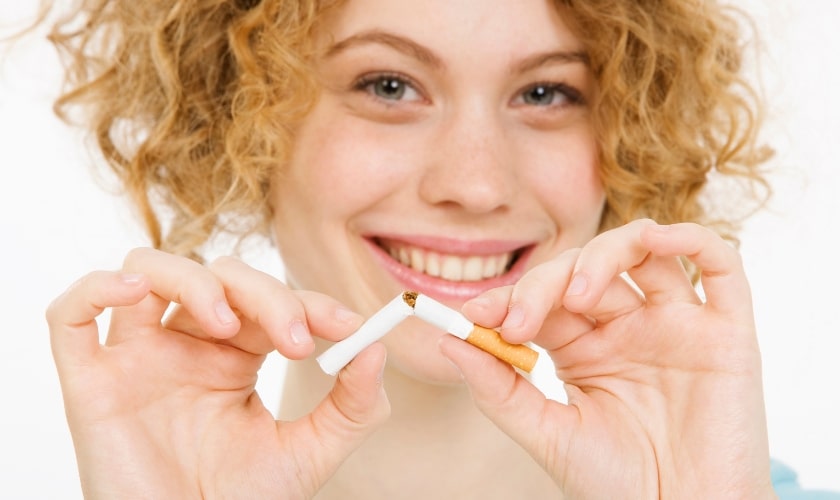
Light up a cigarette, and you might be lighting the fuse on a health crisis. Tobacco use, including cigarettes, cigars, and smokeless tobacco, is a major threat to your overall health, and your mouth is no exception. This section dives deep into the undeniable link between tobacco and some of the most concerning oral health problems.
Oral Cancer: Increased Risk and Early Warning Signs
Let’s start with the most serious consequence: oral cancer. Tobacco use is a major risk factor for developing oral cancer, which can affect the lips, tongue, cheeks, throat, and the floor of the mouth.
Here’s a breakdown of the different types of oral cancer:
- Squamous cell carcinoma: This is the most common type of oral cancer, often affecting the inner lining of the lips and mouth.
- Verrucous carcinoma: This is a less common type that usually grows slowly on the gums, tongue, or inner cheeks.
- Adenocarcinoma: This type of cancer affects the salivary glands in the mouth.
While tobacco use is a significant risk factor, it’s not the only one. Here are some other factors to consider:
- Heavy alcohol consumption
- Excessive sun exposure to the lips
- Human papillomavirus (HPV) infection
- A weakened immune system
Don’t wait for symptoms to appear! Oral cancer can be detected early through regular dental checkups and self-examinations. Here are some warning signs to be aware of:
- A sore or lump in your mouth or on your lip that doesn’t heal
- White or red patches on the gums, tongue, or inner cheeks
- Bleeding, numbness, or tenderness in your mouth
- Difficulty swallowing or chewing
- Loose teeth or dentures that don’t fit well
Early detection is crucial for successful treatment of oral cancer. If you notice these signs, schedule an appointment with your Beaverton dentist immediately.
Gum Disease: From Inflammation to Tooth Loss
Tobacco use doesn’t just threaten your mouth with cancer; it also significantly weakens your gums, leaving them vulnerable to gum disease. Gum disease is a progressive infection that attacks the gum tissue and bone that support your teeth. Here’s how tobacco weakens your gums’ defenses:
- Impairs blood flow: Smoking reduces the amount of oxygen reaching your gums, hindering their ability to fight off infection.
- Weakens immune response: Tobacco disrupts the normal function of your immune system, making it harder for your body to combat the bacteria that cause gum disease.
- Hinders healing: Smoking slows down the healing process after injury or surgery, including dental procedures.
Gum disease progresses through several stages:
- Gingivitis: This is the early stage, marked by inflamed and swollen gums that bleed easily. With good oral hygiene practices and professional dental cleaning, gingivitis is reversible.
- Periodontitis: If left untreated, gingivitis advances to periodontitis, where the infection spreads deeper into the bone supporting your teeth. This can lead to tooth loss.
There are various treatment options available for gum disease, depending on the severity. These may include:
- Professional dental cleaning (scaling and root planing)
- Antibiotics
- Surgery to remove infected tissue or regenerate bone
The best course of action is to prevent gum disease altogether by maintaining good oral hygiene and quitting tobacco use.
Other Oral Health Problems Linked to Tobacco
On top of the major threats like oral cancer and gum disease, tobacco use can wreak havoc on your mouth in various other ways:
- Slowed Healing After Dental Procedures: As mentioned earlier, smoking hinders the healing process after oral surgery or other dental procedures. This can lead to increased risk of infection and complications.
- Increased Risk of Tooth Stains: Tobacco products like cigarettes and chewing tobacco contain substances that stain teeth, leading to discoloration and a dull appearance.
- Bad Breath (Halitosis): Smoking contributes to bad breath by causing dryness in the mouth and killing the good bacteria that help keep breath fresh.
- Taste Alterations: Smoking can dull your sense of taste and smell, making it difficult to enjoy the full flavor of food.
The Road to Recovery: Breaking Free from Tobacco
Now that you understand the significant risks tobacco poses to your oral health, it’s time to explore ways to break free from this harmful habit. Quitting tobacco can be challenging, but the benefits for your smile and overall health are undeniable.
Understanding Addiction: Why Quitting Can Be Tough
Nicotine, the addictive substance found in tobacco, creates a dependence that makes quitting difficult. When you stop using tobacco, your body experiences withdrawal symptoms that can include cravings, irritability, anxiety, and difficulty concentrating.
Developing a Quit Plan: Tailoring Strategies for Success
There’s no one-size-fits-all approach to quitting tobacco. The key is to develop a personalized quit plan that addresses your specific needs and triggers. Here are some steps to consider:
- Set a Quit Date: Choose a specific date in the future to quit tobacco use completely.
- Identify Your Triggers: Recognize situations or emotions that make you crave tobacco.
- Develop Coping Mechanisms: Plan healthy strategies to manage cravings when they arise. This could include exercise, deep breathing, or chewing sugar-free gum.
- Tell Your Support System: Inform your family, friends, and healthcare provider about your decision to quit. Their encouragement can be invaluable.
Nicotine Replacement Therapy (NRT): Exploring Your Options
Nicotine replacement therapy (NRT) can be a helpful tool for managing withdrawal symptoms and cravings. NRT products deliver small amounts of nicotine in a controlled way, helping to ease the transition of tobacco. Here are some common NRT options:
- Nicotine patches: These slow-release patches deliver a steady dose of nicotine through your skin.
- Nicotine gum or lozenges: These provide a quick burst of nicotine when you crave a cigarette.
- Nicotine inhaler: This inhaler delivers nicotine through a mouthpiece, mimicking the sensation of smoking.
Support Systems: Finding Your Quit Smoking Community
Quitting tobacco is easier with support. Consider joining a quit-smoking program or support group to connect with others who are going through the same journey. You can also talk to your Beaverton dentist about resources and medications that might be helpful.
Living Tobacco-Free: The Rewards for Your Smile and Overall Health
The decision to quit tobacco is an investment in your future health and well-being. Here are some of the many rewards you can reap by living tobacco-free:
Improved Appearance: A Brighter, Healthier Smile
Saying goodbye to tobacco means saying goodbye to stained teeth and bad breath. You’ll experience a whiter, brighter smile and fresher breath, boosting your confidence and overall well-being.
Enhanced Sense of Taste and Smell
Tobacco can dull your taste buds and olfactory senses. Once you quit, you’ll rediscover the full flavor and aroma of food, making every meal a more enjoyable experience.
Reduced Risk of Oral Cancer and Other Diseases
The most significant benefit of quitting tobacco is the dramatic reduction in your risk of developing oral cancer and other serious health conditions, including heart disease, stroke, and lung cancer.
More Stamina and Overall Well-Being
Tobacco use reduces your lung capacity and stamina. By quitting, you’ll experience improved breathing, increased energy levels, and an overall sense of vitality.
Making the decision to quit tobacco is a life-changing step. Remember, you’re not alone in this journey. With the right support system, resources, and a commitment to your health, you can break free from tobacco and unlock a healthier, happier future for yourself.
Final Thought
The link between tobacco use and oral health problems is undeniable. From the devastating threat of oral cancer to the damaging effects on your gums and teeth, tobacco takes a heavy toll on your smile and overall health.
However, there is hope. By understanding the risks and taking the courageous step to quit, you can reclaim control of your health and well-being. The rewards are significant – a brighter smile, a sharper sense of taste, reduced risk of disease, and a newfound sense of vitality.
Don’t let tobacco steal your chance for a healthy mouth and a brighter future. Take the first step today. Seek support, develop your quit plan, and commit to a tobacco-free life. Your smile and your body will thank you for it.
Frequently Asked Questions
No, smokeless tobacco products are not safe. While they may not contain the burning tar associated with cigarettes, they still contain nicotine and other harmful chemicals that can lead to oral cancer, gum disease, and other health problems.
Any tobacco use poses a risk to your oral health. Even occasional smoking can irritate your gums, increase your risk of gum disease, and stain your teeth.
There’s no shame in seeking help. Many resources are available to support you on your quit journey. Talk to your dentist about resources and medications that might be helpful. You can also join a quit-smoking program or support group to connect with others who understand the challenges you’re facing.
